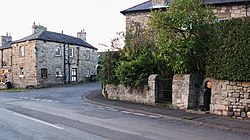Newbrough
| Newbrough | |
| Northumberland | |
|---|---|
 Stanegate, Newbrough | |
| Location | |
| Grid reference: | NY874679 |
| Location: | 55°0’20"N, 2°11’55"W |
| Data | |
| Population: | 561 (2011) |
| Post town: | Hexham |
| Postcode: | NE47 |
| Dialling code: | 01434 |
| Local Government | |
| Council: | Northumberland |
| Parliamentary constituency: |
Hexham |
Newbrough is a village in Northumberland, on the north bank of the River Tyne about five miles west of Hexham.
History
Newbrough was anciently part of the Manor of Thornton. The mediæval tower house known as Thornton Tower was reported to be in a state of decay in a survey in 1541. The Grade II listed building is now completely ruinous.
Sights about the village
Newbrough Hall is an early 19th-century country house at Newbrough. It is a Grade II* listed building.
The estate was held by John Armstrong in 1692 and by John Bacon in the early 18th century. In 1811 the property passed to Bacon's great grandson, the Reverend Henry Wastell.
Wastell built a new house in 1812 adjacent to the old tower, to a design by architect John Dobson. The estate later passed to his daughter and her husband of 1901, Colonel Coulson. They commissioned architect Francis William Deas (1862-1951) to modernise the house in 1902. The resulting two-storey house, with five bays of which the central was pedimented, was extended with two rear wings attached to the 1813 coach house to create a central courtyard. The house was equipped with electricity for which purpose a detached powerhouse was erected in the grounds. The powerhouse, now a separate dwelling, is Grade II listed.
Newbrough Town Hall is thought to be one of the finest in Tynedale: it was built in 1876 and extensively modernised in 2000.[1]
The Women's Institute building, formerly the Mechanics Institute, was built in 1854 and is a grade II listed building. It was given in 1948 to the Newbrough Women's Institute (WI) which was formed in 1923 and is still in existence.[2][3] In 2000 the WI donated the building to the Town Hall, where it now meets (as it did before 1948).[4]
A mile north of the village is a burn known as Meggie's Dene, which is reputedly the burial site of a 16th-century witch called Old Meg. The grave is said to be marked by a pink thorn tree.[5]
Stanegate
Newbrough and Fourstones are on the Stanegate Roman road, built in A.D. 71, which runs from east to west and formed the original northern frontier before the building of Hadrian's Wall. Newbrough's church stands on the site of one of the line of forts along this road.[1][6]
See also
Outside links
| ("Wikimedia Commons" has material about Newbrough) |
References
- ↑ 1.0 1.1 Fourstones and Newbrough villages
- ↑ National Heritage List 1045014: Women's Institute, Newbrough
- ↑ "Newbrough". NationalFederation of Women's Institutes. https://www.thewi.org.uk/become-a-member/structure-of-the-wi/england/northumberland/find-a-wi/newbrough. Retrieved 9 November 2015.
- ↑ "Newbrough WI". Fourstones and Newbrough Village Noticeboard. http://www.fourstonesandnewbrough.co.uk/page44.html. Retrieved 9 November 2015.
- ↑ "Hexham Courant - News - Business - Home's history carved from rich seam of mining industry". Hexham Courant. 8 May 2008. http://www.hexhamcourant.co.uk/news/2.2962/home-s-history-carved-from-rich-seam-of-mining-industry-1.102371. Retrieved 27 August 2014.
- ↑ "Hadrians Wall country". http://www.hadrianswallcountry.org/towndetails.asp?id=37. Retrieved 2008-11-20.
| Forts on Hadrian's Wall | ||
|---|---|---|
| Wall forts (west to east) |
Maia • Coggabata • Aballava • Uxelodunum • Camboglanna • Birdoswald (Banna) • Magnae • Aesica • Housesteads (Vercovicium) • Carrawburgh (Procolita) • Cilurnum • Onnum • Vindobala • Condercum • Pons Aelius • Segedunum | |
| Stanegate forts |
Luguualium • Brampton Old Church • Castle Hill Boothby • Nether Denton • Throp • Magnis • Haltwhistle Burn • Vindolanda • Newbrough • Corstopitum | |
| Outpost Forts |
Habitancum • Fanum Cocidi • Castra Exploratorum • Blatobulgium | |
| Cumberland coast forts (north to south) |
Bibra • Alauna • Burrow Walls • Gabrosentum | |